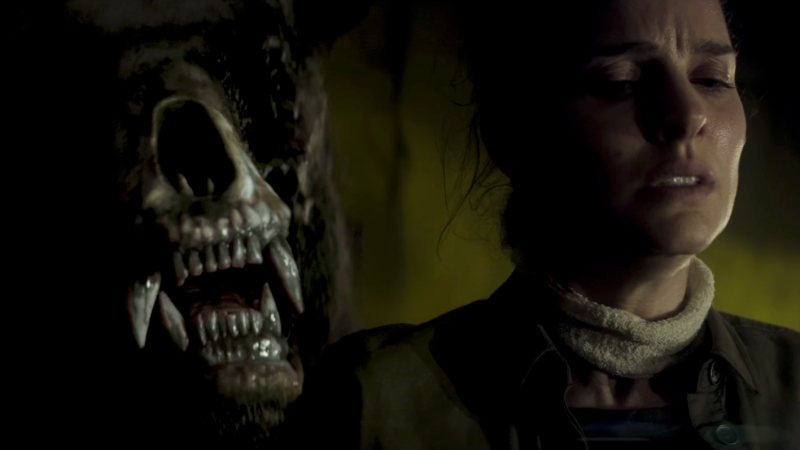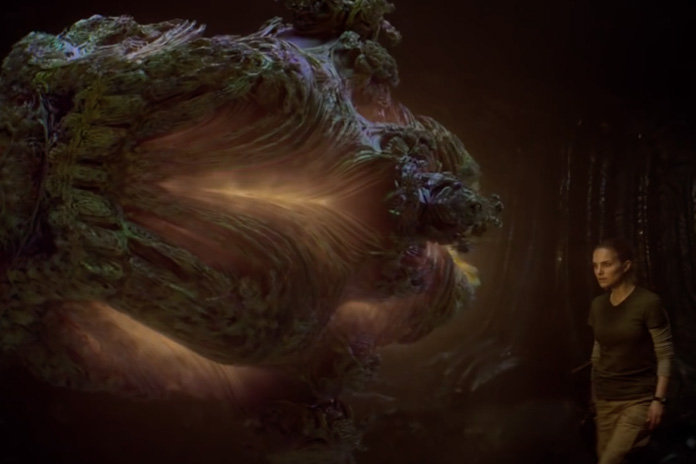The following is a guest post by Will Jones. There will be spoilers.
Science-fiction as a genre has a long-standing tradition of holding a mirror up to society and making us reconsider our place in the larger picture of the universe. From Méliès to Kubrick to Lucas, the greatest storytellers of the genre have posed some of the biggest questions and it’s why their films still resonate to this day. Alex Garland’s new film, Annihilation, joins this fray of great thought-provoking genre cinema this week as he uses a fairly standard plot to explore the depths of humanity and the inherent tension between creation and destruction.
From the very beginning of the film, we are thrust into this conflict. After a brief flash-forward to establish Portman’s Lena as the narrator of the story, we see her teaching a class on cellular biology. She is examining the growth and duplication of cells, as we see something created from nothing before our very eyes. However, the cells are from a tumor. They are creating something new but in the name of destruction. Lena even informs us later that this is essentially true of all cells, self-destruction is coded into our very existence, resulting in death, which she sees as a flaw in our design.
Once Lena arrives at the Southern Reach, a government facility overlooking a bizarre otherworldly event, she insists on going with the team into the Shimmer, something that her superior, Ventress, can’t quite fathom. We learn over the course of the film that each of Lena’s four teammates are all dealing with their own self-destruction in one way or another. Josie cuts herself to feel something, Anya is a recovering alcoholic who drinks to keep her mind clear, Cass is suffering from the loss of her daughter but acts as the mother of the group. Each of these three are a unique balance of destruction and creation, while Ventress is the literal embodiment of the cellular motif from earlier; she has cancer. This leaves the audience, and her teammates, to wonder what could possibly be so wrong with Lena. We eventually learn that Lena was having an affair behind her husband’s back, destroying her marriage in the name of pleasure.
As this team of self-proclaimed ‘damaged goods’ travels into the Shimmer, they find sources of unnatural beauty. Whereas a lesser filmmaker would have played the Shimmer off as yet another dystopian hell-scape full of grey-toned destruction, Garland opts for something much more daring. From the overgrown fauna to the creatures themselves, the setting is full of breathtaking acts of creation. Even as the albino alligator is trying to kill our protagonists, it is acknowledged as a creature of pure beauty. As we later learn, the Shimmer itself is, essentially, a giant prism that is constantly refracting everything within it, even down to a molecular structure. It is constantly creating things anew, entire species of life that did not previously exist.
The bodies of those on the expeditions who came before them and met grisly fates have grown into the environment themselves, become a peaceful and unique part of the ecosystem. When Cass meets her untimely end, a piece of her lives on inside the mouth of the bear that killed her. Josie becomes one with the plant life, its beautiful foliage quite literally covering up her past scars. Within the shimmer, destruction gives way to creation.

In one of the most subdued yet crucially important moments of the film, Lena stumbles upon a deer standing in the middle of the swamp. She raises her gun and takes aim as the deer simply stares at her. Another deer then steps out from behind that one, looking slightly more mutated, but moving in perfect synchrony with the first deer. Lena lowers her weapon as the deer trot away together. Both deer are mutated and changed by the Shimmer, but the original and doppelganger exist in complete, copasetic harmony. The only danger brought on is by Lena herself.

When Lena finally reaches the lighthouse, she does so alone. Ventress has charged on, a few hours ahead of her, and the rest of her teammates have been assimilated by the Shimmer in one way or another. Showcasing the film’s most gorgeous use of set-design, the lighthouse is a sight to behold, with white vines covering the walls and crystal trees just outside. Yet, human skeletons are what lay as a welcome mat in front of the door.

Lena descends into the belly of the lighthouse to find Ventress, who tells her that all that is left for them is ‘annihilation’. While that certainly sounds incredibly foreboding, it is important to note what that word actually means. Annihilation does mean destruction but it also means the conversion of matter into energy. The latter is precisely what happens to Ventress, as she dissipates into particles, forming an entirely new creation. Lena then watches as a drop of her own blood is taken and duplicates, in an exact mirror of both the tumor cells and the deer. From these cells, what the film’s soundtrack refers to as The Alien is born.

This creation mirrors Lena’s every move, acting as a duplicate of herself. When confronted with this, Lena panics and attempts to attack the alien and run away. The alien attacks in return but as Lena later points out, it is only reciprocating her actions. This ends when Lena pulls the pin on a phosphorous grenade and leaves it in the creature’s hands, just as the creature alters its physical appearance to become a literal doppelganger of herself.
Lena’s self-destruction is externalized here. Unlike the deer who lived in harmony with its own doppelganger, Lena immediately tries to destroy hers. With this single move, she teaches the alien the self-destructive nature of humanity, leading to the flame-engulfed creature purposefully igniting the lighthouse itself and destroying the Shimmer.
This inverts the film’s thematic relevance in ways both big and small, essentially casting Lena and her team from Area X as the villains of the film. Their disease, their insatiable desire for self-destruction is in direct contrast with the Shimmer’s own safe haven of creation. They intrude and infect it with their own illness, leading to its ultimate destruction.
Garland’s film is one of many interpretations. One can view the alien at the center of the Shimmer, as a storyteller, or even God, a figure whose own desire for pure creativity is destroyed by those who fear what they do not know. But one of his most brilliant strokes comes from the structure of the film. As we reach the end of the film and return to Lena telling the story to the rest of Area X, she has now taken on the role of creator. She is the storyteller, she is the God. A fact which is reflected by the film’s final shot, as we see a shimmer in her eyes.